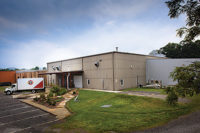
Chilled
beams installed at the Marywood University School of Architecture
reduced energy consumption and saved space.
Colleges and universities are changing the way they approach construction projects, and Marywood University is no exception. This private Catholic university in Scranton, PA, unveiled its new Center for Architectural Studies in August 2009 amid enormous excitement and pride from faculty, students, and the architecture/engineering team.
The Center is the academic facility for the university’s new School of Architecture. Inside the restored walls of a former gym, Marywood students will pursue undergraduate and graduate architectural degrees, including preparation for the LEED® Accredited Professional exam. Lessons in sustainability, energy efficiency, and IAQ literally surround these students as they prepare for a career in architecture. This includes the use of chilled beam technology and advanced energy recovery.
While chilled beams are common in Europe, they are still considered an emerging technology by many in the U.S. That, however, did not discourage the university from implementing the efficiency-focused design proposed by the engineering firm of Greenman-Pedersen, Inc. The firm’s design called for 42 chilled beams to provide 100% of the cooling for both design studio floors of the renovated building. It also included a SEMCO Pinnacle® Primary Ventilation System. The Pinnacle unit utilizes advanced heat wheel technology to dehumidify and precondition supply ventilation air - an important part of the puzzle since chilled beams handle sensible loads only, not latent (humidity) loads.
“I thought it was a great idea,” said Myron Marcinek, assistant director of buildings and grounds at Marywood. “It seemed like a great energy saver and we are very proactive in that.”
Chilled beams reduce the energy consumption of a building in two ways. First, due to chilled beam induction rates, ducted airflow is only needed for the outdoor air requirement. This reduces the amount of system fan energy that is consumed when compared to a VAV system. Secondly, chilled beams utilize a higher chilled water temperature to cool the space, so it places less demand on the chiller plant.
Chilled beams were a good choice for this project because of the limited floor-to-floor space and a cooling dominant load. Since a second level was added to the center of the former gymnasium, there was limited space for ductwork; this led the engineer to choose a dedicated outdoor air delivery system to provide all the necessary ventilation (and proper humidification or de-humidification). They opted for a chilled beam system from SEMCO to satisfy the sensible load. Since large ductwork is not required for the beams (when compared to a VAV system), they are space-efficient, requiring only ceiling space and minimal space for wiring, piping, and ventilation ducting.
Passive chilled beams are also whisper quiet, making them ideal for an open, educational application like the School of Architecture. In fact, the only noise associated with chilled beam cooling is the almost imperceptible flow of water through the coils. They also integrate well with the exposed steel structure and the parallel lighting units suspended from the structural deck above.
HOW IT ALL WORKS
The chilled beams are supplied with cold water from the campus’s central chilled water system. A three-way control valve blends chilled and return water to maintain the temperature within a few degrees above dewpoint to prevent condensation. Typically, chilled water through the beams is maintained between 55°F to 63° - substantially warmer than the chilled water temperature used in a typical VAV system.Although chilled beams offer many advantages, it is critically important to address dehumidification as a separate issue, which is what led Steve Daiute, assistant vice president of Greenman-Pedersen, to choose the SEMCO Pinnacle unit.
“It was the only system that could provide the humidity control we desired without any active regeneration of desiccant material,” said Daiute. The design of the entire system was built around the specific inclusion of the SEMCO Pinnacle unit, which offers a wide operating range and can be highly customized for the application.
The passive dehumidification wheel in the Pinnacle system dehumidifies the supply air to a dewpoint far lower than any standard A/C equipment can provide. This deep dehumidification satisfies the building latent load with much less airflow than what could be required by typical air conditioning equipment. Combining the most energy efficient ventilation/latent load system (Pinnacle) with the most energy efficient sensible load system (chilled beams) is a win-win combination for the school.
The Pinnacle system pre-cools and dehumidifies outdoor air during the cooling season; it also preheats and humidifies the outdoor air during the heating season. Pre-tempering and dehumidification are both accomplished by recovering (or rejecting) heat from the exhaust airstream via the heat wheels. The Pinnacle system responds to variations in temperature and humidity by modulating the rotational speed of the passive dehumidification wheel, and/or adjusting the energy input to the cooling coil. The rotational speed control may be adjusted to control the level of temperature and moisture exchanged by the passive dehumidification wheel.
PURE INSPIRATION
The University’s School of Architecture anticipates earning LEED Gold certification for the newly-renovated building. The application of the chilled beams and energy recovery technology will enable Marywood University to achieve several points under “LEED Energy and Atmosphere, Credit 1: Optimize Energy Performance.” More important, the students and faculty are enjoying a healthier, more comfortable environment at a reduced carbon footprint. It is also a source of great pride for Myron Marcinek and many others at the university.“It was a great project and learning experience,” said Marcinek. “It’s really exciting to see this change in the way we are designing our buildings.”
Change would be an understatement for the Center for Architectural Studies, where 83% of the construction waste was reused in some way - either for the newly-renovated building or for some other useful purpose - like salvaging fiberglass window panels from the former gym and giving them to a local organic farmer to use in building a greenhouse. It’s a building that will undoubtedly inspire future architects for years to come.ES

